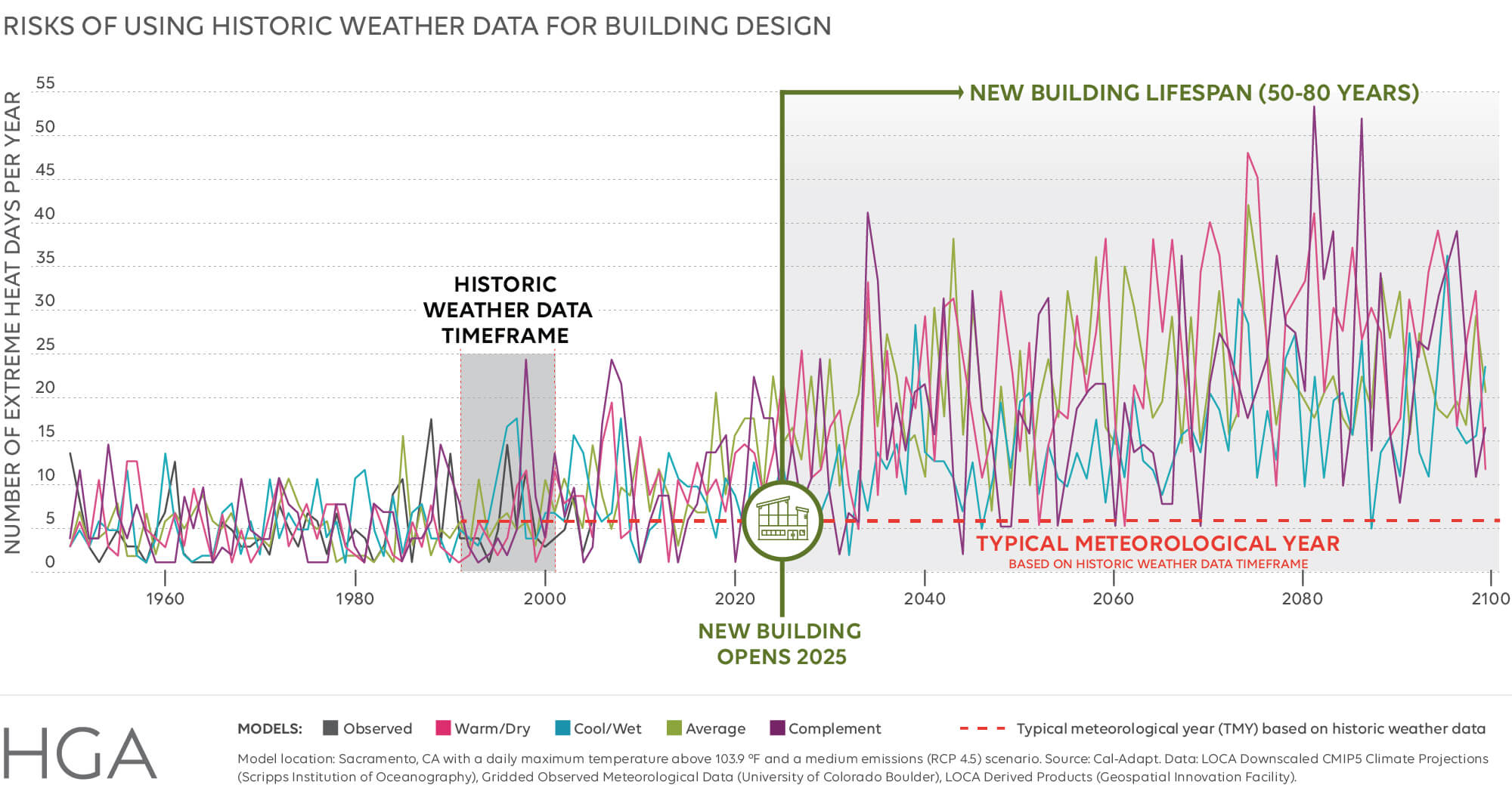Architects & Engineers (A&E) are well-positioned to use climate projection data, yet there remains a concerning lag in industry-wide adoption of these forward-looking metrics. A joint study from HGA and the University of Minnesota Climate Adaptation Partnership takes a closer look at this disconnect.
A&E professionals typically rely on historical weather data as a primary resource for performance analysis and design. This data, based on past median weather conditions and sometimes more than three decades old, has traditionally been considered sufficient for establishing ‘climate normals’, and is reinforced by existing standards, laws, and conventions. However, our changing climate renders these characterizations much less useful, poorly reflecting the range, frequency, and intensity of potential future weather conditions that a building will need to withstand during its lifespan. Put simply—changes in climate that have already occurred and are projected to occur must be accounted for when designing for climate change adaptation and mitigation.

To better understand how building professionals are (or aren’t) addressing this tension between the lack of codified climate projection data and the obligation to design a built environment prepared for climate risk, HGA and the University of Minnesota Climate Adaptation Partnership (MCAP) conducted a study focused on the current practice, barriers and opportunities related to the use of climate projection data, and the state of current climate change and resiliency services by A&E professionals in the United States.
This mixed-method study was conducted between April 2022 and November 2022, and involved a tiered approach including a literature review, an online survey, and focus groups.
Download Climate Forward? How Climate Projections Are(n’t) Used to Inform Design.
Key Findings
The resulting report details four key findings that demonstrate a gap between the current state of A&E practice and climate science and articulates a key role for boundary organizations and climate data developers for building partnerships and capacities to bridge this gap alongside A&E professionals.

- 1. Sustainable design services are primarily focused on climate change mitigation (reducing carbon emissions) and do not often include designing for climate change resilience (design measures that factor in the projected climate over the lifespan of the building and systems).
- 2. While A&E professionals are aware of and interested in using climate projection data in their work, few firms are regularly using projections to inform design decisions.
- 3. A&E professionals identify a number of barriers to using climate projection data, including a lack of client requests; a lack of standards and codes; resolution needs; format, content, and cost; trust of the data; and a need for internal expertise to use the data.
- 4. There is a strong need for the development and promotion of industry standards, mandates (including building codes), guidance and training for using climate projections in A&E applications.
View the Adaptation in Action Webinar — Climate Forward? How Climate Projections Are(n’t) Used to Inform Design.
This presentation features HGA Director of Sustainability Ariane Laxo and UMN Masters student and HGA/MCAP intern Patrick Cipriano, discussing how architecture and engineering professionals are well-positioned to use climate projection data to inform design and provide clients with climate adaptive solutions.
The climate is changing rapidly. Action must be taken now, and must involve substantive collaboration with climate data developers, boundary organizations, A&E associations and professionals, policy makers, building code & standards bodies, higher education institutions, and any organization that hires A&E professionals. Together, we can build a more resilient future.
To learn more about the findings, please contact HGA Director of Sustainability, Ariane Laxo. For media inquiries, please contact our Public Relations Director, Michelle Nelsen.
About MCAP
The University of Minnesota Climate Adaptation Partnership (MCAP) is a partnership among university, public, non-profit, and private sector groups organized to support Minnesota’s ability to adapt to a changing climate. MCAP conducts cutting-edge climate and adaptation research, champions climate leadership, develops the next generation of adaptation professionals, and advances implementation of effective, equitable adaptation actions across sectors, communities, and levels of government. Learn more about MCAP at climate.umn.edu or follow us on Twitter or LinkedIn.
About HGA
HGA is a national interdisciplinary design firm committed to making a positive, lasting impact for our clients and communities through research-based, holistic solutions. We believe that great design requires a sense of curiosity—forming deep insight into our clients, their contexts, and the human condition. We are a collective of over 1,000 architects, engineers, interior designers, planners, researchers, and strategists. Our practice spans multiple markets, including corporate, cultural, education, local and federal government, healthcare, and science and technology. Visit HGA.com or follow on LinkedIn, Instagram, Facebook, and Twitter.
Stay up to date with the latest industry news and updates, sign up for Sustainability and Resilience insights and research.
By submitting this form, you are consenting to receive marketing emails from: . You can revoke your consent to receive emails at any time by using the SafeUnsubscribe® link, found at the bottom of every email. Emails are serviced by Constant Contact
